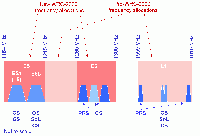If you wish to contribute or participate in the discussions about articles you are invited to contact the Editor
GALILEO Commercial Service
| GALILEO | |
|---|---|
| Title | GALILEO Commercial Service |
| Author(s) | GMV |
| Level | Basic |
| Year of Publication | 2011 |
The GALILEO System will be an independent, global, European-controlled, satellite-based navigation system and will provide a number of guaranteed services to users equipped with Galileo-compatible receivers. The GALILEO Commercial Service ......
The Commercial Service (CS) is aimed at market applications requiring higher performance than offered by the Open Service. It provides added value services on payment of a fee. CS is based on adding two signals to the open access signals. This pair of signals is protected through commercial encryption, which is managed by the service providers and the future Galileo operator. Access is controlled at the receiver level, using access-protection keys.
combination of two encrypted signals for higher data throughput rate and higher accuracy authenticated data
The uses foreseen for the commercial service include data broadcasting and resolving ambiguities in differential applications. These will be developed by service providers, which will buy the right to use the two commercial signals from the Galileo operator.
Developing commercial applications either by using the commercial signals alone, or by combining them with other Galileo signals or external communications systems, opens a wide range of possibilities. The worldwide coverage brings a strong advantage for applications requiring global data broadcast.
Typical value-added services include service guarantees, precise timing services, the provision of ionosphere delay models, local differential correction signals for extreme-precision position determination and other services based on the broadcast of system information data.
Purpose
The Galileo Open Service (OS) provides positioning, velocity and timing information that can be accessed free of direct user charge. This service is suitable for mass-market applications, such as in-car navigation and hybridisation with mobile telephones. The Open Service is accessible to any user equipped with a receiver, with no authorisation required. While up to three separate signal frequencies are offered within the Open Service, cheap single-frequency receivers will be used for applications requiring only reduced accuracy. In general, Open Service applications will use a combination of Galileo and GPS signals, which will improve performance in severe environments such as urban areas. The timing service is synchronised with UTC when used with receivers in fixed locations. This timing service can be used for applications such as network synchronisation or scientific applications.[1]
The Open Service does not offer integrity information, and the determination of the quality of the signals will be left entirely to the users. There will be no service guarantee or liability from the Galileo Operating Company on the Open Service.[2]
Performance and features
The Galileo Open Service is realized by using the signals at L1, E5a and E5b, whether data or pilot. Several combinations are also possible, such as a dual frequency service based on using L1 and E5a (for best ionospheric error cancellation) or single frequency services (at L1, E5a, E5b or E5a and E5b together) in which case the ionospheric error is removed using a model, and even triple frequency services using all the signal together (L1, E5a and E5b), which can be exploited for very precise, centimetric applications.[2].[3]
The performance objectives in terms of position accuracy and availability will be competitive with respect to existing GNSS and further planned evolutions. In addition, the Open Service will also be interoperable with other GNSS, in order to facilitate the provision of combined services. [1]
| Galileo Open Service (positioning & timing) | ||
|---|---|---|
| Single Frequency (SF) | Dual Frequency (DF) | |
| Coverage | Global | |
| Accuracy (95%) | Horizontal: 15 m | Horizontal: 4m |
| Vertical: 35 m | Vertical: 8m | |
| Availability | 99.8 % | |
| Timing Accuracy wrt UTC/TAI | 30 ns | |
| Ionospheric Correction | Based on SF Model | Based on DF Measurements |
| Integrity | No | |
To know more information about Performances of each Galileo Service see the article Galileo Performances.
Implementation
The Open Service signals are separated in frequency to permit the correction of errors induced by ionospheric effects by differentiation of the ranging measurements made at each frequency. Each navigation frequency will include two ranging code signals (in-phase and quadrature). Data are added to one of the ranging codes while the other “pilot” ranging code is data-less for more precise and robust navigation measurements.
During the Initial Operational Capability (IOC) phase, the GALILEO open service, the search and rescue service and the PRS will be provided. At this stage, however, accuracy and availability will not yet have reached their optimum levels.[4]


